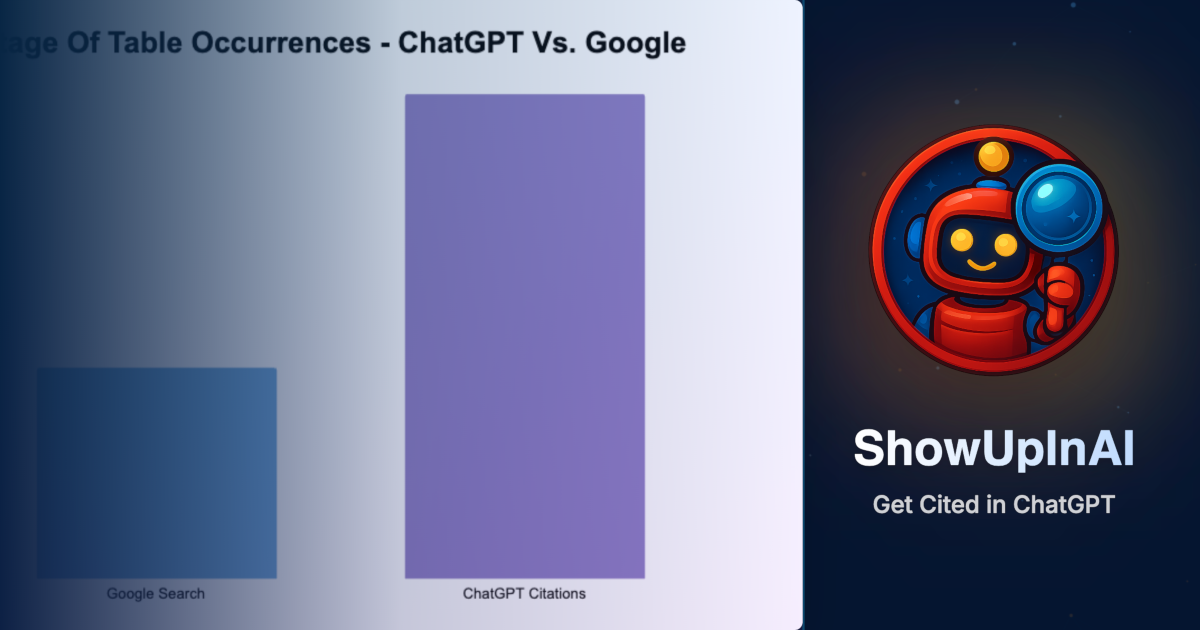Do You Need Schema Markup for AI Visibility? 2025 Answer
Does schema markup work for AI SEO? Recent research reveals what AI assistants really prioritize and what you should actually focus on instead.

If you're diving into AI SEO (also called GEO - Generative Engine Optimization), you've probably heard a lot about schema markup and structured data.
SEO experts are talking about it. Agencies are selling it as a service. Blog posts promise it'll get you more ChatGPT citations.
But here's the question nobody's giving you a straight answer on: Does schema markup actually help with AI visibility?
The short answer: It's complicated—and recent research just changed everything.
What the Latest Research Actually Shows
In late 2024, two well-respected SEO researchers—Mark Williams-Cook and Julio C. Guevara—ran some tests that honestly shocked a lot of us in the AI SEO community.
Their findings, published on SEO Round Table, revealed something surprising:
AI assistants prioritize visible text over hidden structured data.
Here's what they tested:
- Two product pages: one with visible text + schema markup, another with only schema markup (no visible content)
- They tried hundreds of extraction prompts to see if AI models could extract product details (price, colors, SKU numbers)
- Result: It only worked on the page with visible text
As Guevara put it: "Surprise, surprise: this only worked on the page with information visible as text."
So... Should You Even Bother with Schema Markup?
Here's the honest answer for beginners:
Schema markup won't hurt you, but it's not the magic bullet for AI visibility that many people claim.
Think of it like this:
- Schema markup = Nice-to-have organizational tool that might help AI systems understand your content structure
- Visible, clear text content = Actually what AI assistants read and cite
- Fast indexing (via IndexNow) = How AI systems discover your content quickly
- AI view verification = How you confirm what AI actually sees on your page
The Real Priority: Focus on making your important information clearly visible as text, get it indexed fast in Bing (which powers ChatGPT, Copilot, and Perplexity), and verify what AI systems actually see.
What Actually Matters More for AI Visibility
Based on the latest research and real-world results, here's what you should prioritize:
1. Visible Text Optimization (Priority #1)
Make sure your key information is clearly visible as text on your pages:
- Product prices and specifications
- Author credentials and expertise
- Key facts and data points
- Detailed descriptions and explanations
Why it matters: AI models tokenize and process visible text, not hidden schema markup.
2. Fast Bing Indexing via IndexNow (Priority #2)
With Google's recent removal of the &num=100 parameter, Bing has become the primary gateway for AI visibility. IndexNow gets your content indexed in Bing within minutes instead of weeks.
Why it matters: ChatGPT, Copilot, and Perplexity all rely on Bing's index. Fast indexing = faster AI discovery.
3. AI View Verification (Priority #3)
Use ShowUpInAI's AI view feature to see exactly how AI assistants interpret your page. It shows you the markdown representation of your content—the same format AI models actually process.
Why it matters: You can't optimize what you can't measure. AI view shows you what AI actually sees.
4. Schema Markup (Secondary - But Still Useful)
Schema markup is still worth implementing, but as a secondary priority for organizational benefits rather than as a primary AI visibility strategy.
Why it matters: It doesn't hurt, it helps organize your content, and there's potential for future AI improvements in how structured data is processed.
But If You Still Want to Implement Schema Markup...
If you're thinking "okay, but I still want to add schema markup just to cover my bases"—that's totally fair. Here's a beginner-friendly overview of the main types you might consider.
What Is Schema Markup, Anyway?
In simple terms, schema markup is a way to label parts of your webpage so that machines (like AI assistants) can understand what each piece of content represents.
It's like adding notes to your content saying "this is an article," "this person is the author," "this is a product with these specifications," etc.
The most common format is called JSON-LD, which is just a block of code you add to your page's HTML that describes what's on the page.
The Main Schema Types (Simplified)
Here are the most common schema types you might use:
1. Article Schema - For blog posts and articles
- Tells AI this is an article with an author, publish date, etc.
- Basic info that helps organize your content
2. FAQ Schema - For question-and-answer content
- Labels your Q&A pairs so AI can potentially extract them
- Works well for pages with common questions
3. Product Schema - For e-commerce and product pages
- Describes products with prices, availability, ratings
- Most useful for product comparisons
4. HowTo Schema - For step-by-step guides
- Structures instructional content into clear steps
- Good for tutorial-style content
5. Person/Organization Schema - For author and company info
- Establishes who you are and your credentials
- Can help with E-A-T (Expertise, Authority, Trust) signals
Remember: These schemas are organizational tools, not magic bullets. Your visible text content is what AI actually reads and cites.
Want the Technical Deep Dive?
If you're interested in advanced schema implementation strategies, nested schema structures, dynamic generation, and detailed code examples, we've got you covered.
Check out our comprehensive guide: Advanced Schema & Structured Data: What Actually Works for AI Assistants
That guide includes:
- Complete schema implementation examples with full code
- Advanced nested schema strategies
- Testing and validation approaches
- Real case studies with results
- The full research findings on visible text vs. schema markup
Advanced vs. Beginner
This post is designed for beginners who want to understand the basics. Our advanced guide is for those ready to dive deep into technical implementation details.
The Beginner-Friendly Action Plan
If you're just getting started with AI visibility, here's your priority order:
Phase 1: Get the Basics Right (Week 1)
1. Optimize Your Visible Text
- Make sure key information is clearly visible on your pages
- Include author credentials, product specs, key facts as readable text
- Don't hide important information in JavaScript or complex elements
2. Set Up IndexNow for Fast Bing Indexing
- IndexNow gets your content into Bing (which powers ChatGPT, Copilot, Perplexity) within minutes
- This is WAY more important than schema markup for AI visibility
- ShowUpInAI automates this entire process across unlimited domains
3. Verify What AI Sees
- Use ShowUpInAI's AI view to see how AI assistants actually interpret your content
- This shows you the markdown representation AI models process
- Identify and fix any issues where important content isn't visible to AI
Phase 2: Add Schema Markup (Week 2-3)
Once you've got the basics covered, you can add schema markup:
- Start with Article schema for blog posts
- Add FAQ schema if you have Q&A content
- Consider Product schema for e-commerce
- Use Person/Organization schema to establish authority
But remember: This is secondary to visible text and fast indexing.
Phase 3: Monitor and Optimize (Ongoing)
- Track which content gets AI citations
- Monitor what queries trigger your content
- Continuously optimize based on what's working
- Keep your IndexNow automation running (ShowUpInAI handles this)
The Bottom Line: Don't Overthink Schema Markup
Here's what you need to remember:
✅ Do This First:
- Optimize visible text content
- Get fast Bing indexing with IndexNow
- Verify what AI sees with AI view
- Focus on content quality and clarity
✅ Then Consider:
- Basic schema markup for organization
- Structured data as a nice-to-have
- Advanced implementations if you have time/resources
❌ Don't Do This:
- Obsess over schema markup while ignoring visible text
- Implement complex nested schemas before basic optimization
- Expect schema alone to magically boost AI visibility
- Skip IndexNow thinking schema is enough
Real Talk: Most businesses would see better results spending 1 hour optimizing visible text and setting up IndexNow than spending 10 hours implementing perfect schema markup. Prioritize accordingly.
How ShowUpInAI Makes This Easy
Instead of juggling multiple tools and technical implementations, ShowUpInAI handles the most important parts automatically:
✓ Daily automatic crawling to detect new and updated content
✓ Smart IndexNow submissions to Bing whenever content changes
✓ AI view to see exactly what AI assistants see on your pages
✓ Unlimited domains - perfect if you manage multiple sites
✓ Citation tracking to monitor what's working
You focus on creating great content. We handle getting it discovered by AI.
Stop worrying about schema markup and start focusing on what actually works. Try ShowUpInAI free and get automated IndexNow, AI view verification, and citation tracking across all your domains.
Start Your Free TrialFurther Reading
Want to learn more about AI visibility strategies?
- Why IndexNow Is Now Essential for AI Visibility - Learn why fast Bing indexing is now the #1 priority for AI SEO
- Advanced Schema & Structured Data for AI Assistants - Deep dive into technical schema implementation with full code examples
- GEO (Generative Engine Optimization) - Complete guide to optimizing for AI assistants
The AI visibility landscape is evolving fast. Stay focused on what actually works: visible text, fast indexing, and verification. Schema markup is just the cherry on top.


